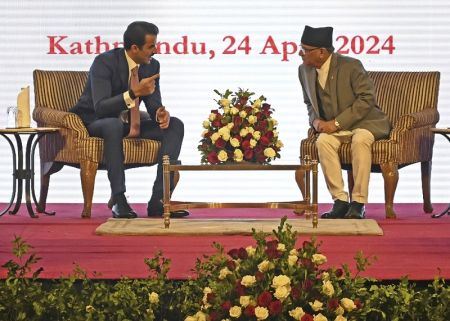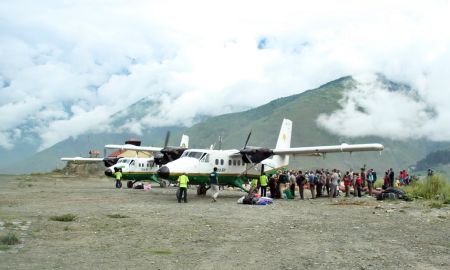.jpg)
--By Bhawani Timalsina
The cinema-going culture has now shifted largely from the single screen to multiplex venues. Multiplexes have brought about a revolutionary change in the movie-watching experience. Over the last few years, multiplexes have emerged as a growing trend in cities. The trend began in Nepal when four years ago Big Movies installed a multiplex cinema for the first time. Soon after, the others followed suit. QFX, F-Cube and Big Movies chains are some of the renowned multiplexes in the city. However, the trend of digitization was initiated by the QFX centre after acquiring Jai Nepal cinema hall in 2000.
Experts opine that multiplexes lure the audience mainly through technologies that make films more visually appealing. Alongside movie watching, multiplexes offer other attractive facilities such as complimentary pop-corns, game-zones, separate lounges and a good ambience. Multiplexes offer quality experience to the audience. Multiplex are provided with operators more opportunities to grow as conventional cinema halls lack enough resources to maintain quality, operators say.
Film makers in Nepal say that the multiplex cinema halls here have been playing a key role in uplifting the Nepali film industry. New film-makers have been thrilled with the response they have received from the audience in multiplex movie halls. Film producer and director Nischal Basnet says, “The trend is positive for Nepali film-makers as the multiplexes have attracted audiences that previously neglected Nepali films. These are audiences that regard ambience and facility as important aspects of the movie-watching experience.”
Infrastructure Officer of the Film Development Board Nepal, Harihar Rekhoula, agrees that the multiplexes have helped in promoting Nepali films. Rekhoula agrees that the multiplexes have given a new avenue to promote Nepali films and opines that audiences should encourage Nepali films by watching them.
Chairman of Quest Entertainment Pvt Ltd Nakim Uddin is pleased with the response the multiplex halls have received recently. “We have been receiving a positive response from the audiences ever since the inception of Jai Nepal cinema hall,” he claims.
Similarly, Rakesh Shrestha, Managing Operator of Big Movies sees investment in the movie exhibition business (multiplex) has huge potential. “New players are emerging in the business and the market has been expanding,” he says. Shrestha is optimistic and confident that the future of the film exhibition business will remain bright as positive responses from movie-goers have prompted new investors as well. “Growing competition helps expand the market,” he adds.
Dr Pradeep Bhattarai, President of Film Critics Society Nepal (FCSN), mentioned in his presentation ‘Setting the Scene: Nepal and Film Market’ at the Workshop on Copyright for Film Professionals held in Kathmandu in December 2012, that investment in the film exhibition business has increased with the introduction of multiplexes.
According to the Film Development Board, there are 215 film theatres and 43 high vision halls in Nepal. Out of them, 90 percent are following the digital format whereas the rest are under process. “Audiences are now ready to pay overpriced tickets, though it was quite difficult to convince them in the beginning,” says Roshan Adiga, Chief Operating Officer (COO) of QFX Cinemas. Adiga also mentions that online booking and online purchasing are additional facilities of multiplexes that encourage ticket-buying. Tickets at multiplexes are priced from Rs 175 to Rs 400, and occupancy in general is 70-80 percent when a good movie is on, according to Shrestha, who speaks for Big Cinemas alone.
Multiplexes have the ability to screen a single film in several auditoria via interlinked equipment in a single projection room. Due to this, multiplex operators accommodate a broad choice of films to attract large audiences. Given the range of price in tickets and variety of choice in films, multiplexes have also become a recreation centre for people of all classes.
Malls and Multiplexes
Multiplexes have always been an integral part of shopping malls worldwide. In the context of Nepal, renowned multiplexes such as QFX, F-Cube and Big cinemas are located in famous shopping malls – the QFX Central in Civil mall, Big Cinemas in City Centre and F-Cube in KL tower. Adiga says that malls and multiplexes are integral as both have to depend upon each other for footfalls. The increasing number of shopping malls in Kathmandu has boosted the number of multiplexes. Co-location of malls and multiplexes are beneficial as multiplexes help increase sales, say operators at malls.
Increasing Investment Volume in Film Exhibition
The movie-watching experience has changed with the multiplex boom. Trends indicate change in the financial aspect of the entertainment sector. The massive success of multiplexes has attracted huge amounts of investment in the exhibition business. Multiplex operators are optimistic that the multiplex business will reach heights with increasing competitors and expansion plans in the days to come. The rise of the multiplex has pressurized single stand cinema halls to improve quality and facility. Multiplex owners have also lured good revenue from food vendors and advertisements as most of them have been tying up with various brands.
Average cost of the multi-screen cinema
Quest Entertainment invested Rs 30 million in Jai Nepal and Rs 45 million in Kumari Cinema hall. According to multiplex operators, the cost of multiplex business would be Rs 50 million in average. However, cost also depend upon the quality of technology and other factors affecting investment. According to Shrestha, the cost can range from Rs 70 million to Rs 90 million given different technologies and business capacity.
Upcoming Multiplexes
The QFX Centre is planning to roll out a 3-auditoria multiplex in Lalitpur in the near future. The company informs that the project will be completed within a year. Some old single stand theaters are also set to build multi-screen cinema halls. Some of Kathmandu’s oldest cinema halls like Bishwojyoti and Ranjana halls have already begun the venture. Big Movies has also been planning to come up with other projects in the days to come.
.jpg)





















